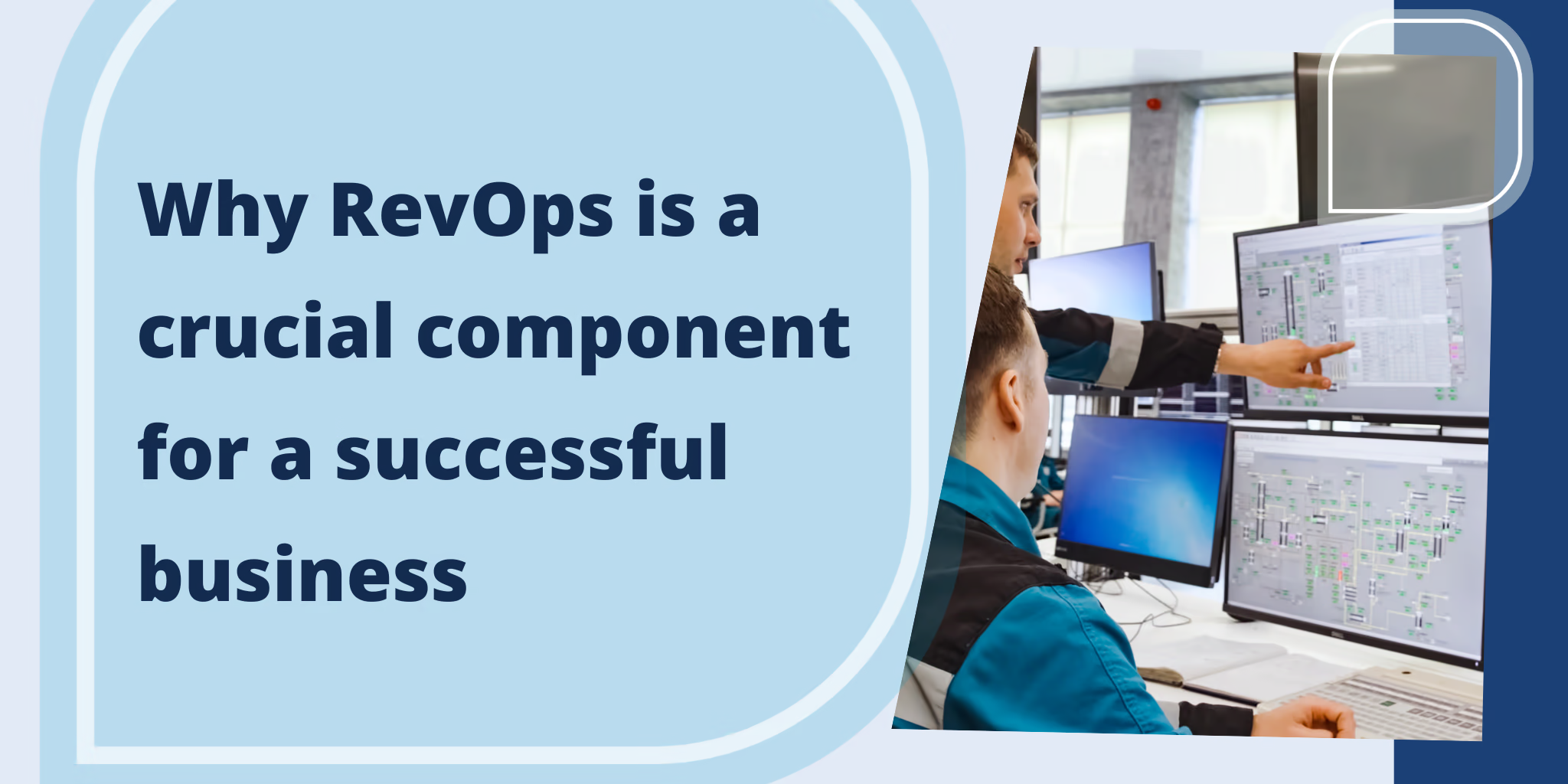Table of Contents
- Introduction
- Definition of Revenue Operations (RevOps)
- Evolution and Importance of RevOps
- Key Benefits of Implementing RevOps
- Core Components of RevOps: People, Process, Technology, Data
- How RevOps Differs from Traditional Sales, Marketing, and Customer Success Operations
- Competitive Comparisons: RevOps vs. Other Growth Models
- Sales-Led Growth (SLG)
- Product-Led Growth (PLG)
- Marketing-Led Growth (MLG)
- Implementing a RevOps Strategy
- Best Practices and Frameworks
- Challenges in Implementing RevOps (Common Pitfalls and Mistakes)
- Challenges for Early-Stage Companies
- Challenges for Enterprises
- Role of Technology and Automation in RevOps
- Organizational Structures and Team Composition in RevOps
- Industry-Specific Examples and Case Studies
- Future Trends and Predictions for RevOps
- Conclusion
- References
1. Introduction
Revenue Operations—commonly known as RevOps—has rapidly become a cornerstone of modern B2B strategy. As businesses scale and markets evolve, aligning every revenue-generating function under a unified approach is no longer optional; it’s essential for sustainable growth. This guide provides an authoritative, in-depth exploration of RevOps: what it is, why it matters, its key components, and how to implement it effectively. We will also examine how RevOps compares to traditional operational models and other growth strategies, outline best practices and common challenges in adopting RevOps, delve into the vital role of technology, discuss the organizational structures that make RevOps successful, and explore industry-specific examples. Finally, we’ll look ahead at future trends and predictions shaping the world of RevOps. The goal is to offer a comprehensive yet navigable resource to help you understand and implement this critical business function.2. Definition of Revenue Operations (RevOps)
RevOps Tip:
When implementing RevOps, start by creating a shared definition of key terms like “qualified lead” or “customer success” across all departments. This ensures everyone is speaking the same language and working towards the same goals.
3. Evolution and Importance of RevOps
RevOps emerged as a response to the shortcomings of traditional, siloed operations. Historically, many companies established separate teams—Sales Operations, Marketing Operations, and Customer Success Operations—to optimize each function’s performance in isolation. While this specialization brought operational gains within departments, it often resulted in fragmented customer experiences and misaligned objectives across the revenue funnel. By the mid-2010s, forward-thinking companies recognized the need for a more unified operational model that spanned the entire revenue process, leading to the rise of Revenue Operations. This shift was further driven by modern buyers’ expectations for seamless journeys: from their first brand interaction to post-sale support and beyond. The importance of RevOps continues to grow, particularly as businesses become more data-driven and customer-centric. Many organizations that adopt a RevOps model report faster revenue growth, higher customer lifetime value, and more predictable forecasting. It’s now seen as a critical discipline for scaling digital-first sales motions and ensuring that every part of the revenue engine runs in sync.Key Takeaways:
- RevOps emerged as a response to siloed operations
- It aligns with modern buyers’ expectations for seamless journeys
- Organizations with RevOps report faster revenue growth and higher customer lifetime value
4. Key Benefits of Implementing RevOps
Let’s visualize some of the improvements companies have seen after implementing RevOps:
Increase in lead generation:
50% increase in lead generation reported by a tech company after synchronizing sales and marketing through RevOps.
Reduction in manual tasks:
99% reduction in time spent on manual tasks achieved by an e-commerce payment solutions provider after revamping their RevOps.
- Unified Direction and Alignment: By creating a single source of truth for goals and metrics, RevOps ensures that all teams—marketing, sales, customer success, and others—share the same targets. Departmental misalignments and finger-pointing are replaced by a cohesive revenue strategy where everyone understands how their work impacts overall results.
- Improved Efficiency and Productivity: When departments collaborate on the same processes and share standardized tools, redundant steps and bottlenecks are eliminated. Handoffs become smoother, sales cycles can shorten, and customer onboarding can happen faster. This operational streamlining often leads to reduced costs and less “leakage” of revenue opportunities.
- Data-Driven Decision Making: One of RevOps’ core pillars is integrating and cleaning revenue data across functions, providing leaders with comprehensive insights. Instead of each department running separate reports, there is one unified view of the pipeline, funnel conversion metrics, churn drivers, upsell opportunities, and more. This clarity fuels evidence-based strategies.
- Enhanced Customer Experience and Retention: By focusing on the entire customer lifecycle, RevOps removes the gaps between marketing, sales, and support touchpoints. Customers experience consistent messaging and a smoother journey from one stage to the next. Better experiences lead to higher satisfaction, increased retention, and more successful upsells or cross-sells.
- Greater Accountability and Performance Measurement: Shared dashboards and company-wide KPIs create transparency. Issues are identified quickly, and continuous improvement becomes part of the culture. Additionally, compensation plans can be better aligned to overarching revenue goals, making it clear that everyone’s success depends on collective performance.
- Revenue Growth and Predictability: Aligning teams, optimizing processes, leveraging solid data, and standardizing best practices typically results in accelerated and more predictable revenue growth. Leaders gain confidence in forecasts and can plan for investments or course-corrections with fewer surprises.
5. Core Components of RevOps: People, Process, Technology, Data
RevOps can be understood through four core pillars that support a successful function:People
This pillar focuses on team structures, roles, and collaboration. It often includes a dedicated RevOps team or leader overseeing cross-functional initiatives, ensuring that marketing, sales, and customer success communicate seamlessly. RevOps professionals typically have diverse skill sets—ranging from operational excellence to analytics and strategy—and serve as “translators” who unify different functions.Process
Under RevOps, the entire revenue pipeline is mapped out to ensure every handoff—from marketing to sales to support—happens efficiently. By standardizing workflows and establishing governance (e.g., clear rules for data entry, handoff protocols, or approval processes), RevOps removes friction points that traditionally slowed deals or confused customers.Technology
Technology is the backbone of RevOps, providing the tools for data integration, analytics, and workflow automation. Rather than having separate, siloed software, RevOps emphasizes a cohesive tech stack—CRM, marketing automation, customer success platforms, and more—so that all teams operate on shared, real-time information. Automated processes reduce manual work and free teams for higher-value tasks.Data
Data is both the foundation and the thread that connects people, processes, and technology. RevOps aims to establish a single source of truth for all revenue-related metrics and customer information. This requires consolidating, cleaning, and governing data across departments. Ultimately, having reliable data enables advanced analytics, accurate forecasting, and a culture of evidence-based decision-making.RevOps Best Practice:
Invest in a robust, integrated tech stack that allows for seamless data flow between marketing, sales, and customer success platforms. This integration is crucial for creating a single source of truth and enabling data-driven decision making across the entire revenue cycle.
6. How RevOps Differs from Traditional Sales, Marketing, and Customer Success Operations
In the traditional model, each department tends to have its own operations team—Sales Ops, Marketing Ops, Customer Success Ops—each focusing on departmental goals, processes, and metrics. This often leads to:- Silos: Limited visibility into other teams’ activities or data, causing poor handoffs and misaligned strategies.
- Conflicting Goals: Marketing might optimize for lead volume, sales for closed deals, and CS for retention, without a unifying KPI.
- Inefficiency: Duplicate efforts, inconsistent data definitions, and unnecessary frictions at every customer touchpoint.
- Takes a holistic, end-to-end view of the revenue cycle, from the first marketing touch to renewal and expansion.
- Aligns objectives by defining shared metrics and incentives for all revenue teams.
- Integrates data and processes so that transitions and reporting are seamless, and each department is aware of how it impacts the others.
7. Competitive Comparisons: RevOps vs. Other Growth Models
Beyond contrasting RevOps with traditional siloed operations, it’s also helpful to compare RevOps with three common growth strategies: Sales-Led Growth (SLG), Product-Led Growth (PLG), and Marketing-Led Growth (MLG).RevOps vs. Sales-Led Growth (SLG)
A Sales-Led Growth model emphasizes the sales team as the primary revenue driver. While it can deliver focused, high-touch engagement—especially for large, complex deals—it often generates higher customer acquisition costs and risks departmental silos. RevOps, on the other hand, unites marketing, sales, and CS under one revenue strategy, improving efficiency and reducing potential friction. An SLG model can be effective for early-stage or high-value enterprise deals, but as organizations scale, layering in RevOps helps maintain alignment across the full customer lifecycle.RevOps vs. Product-Led Growth (PLG)
Product-Led Growth hinges on the product itself as the main driver of acquisition and expansion, often through free trials or freemium offerings. PLG can create a loyal user base with lower acquisition costs but may result in slower revenue ramp-up and less direct control over the sales funnel. RevOps complements PLG by ensuring the entire organization—product, marketing, sales, and support—collaborates on data and processes. For instance, if the product-led funnel isn’t converting at a certain stage, a RevOps team can introduce targeted sales outreach or refine the onboarding process based on shared insights. Essentially, PLG focuses on how you grow, while RevOps focuses on how you run your growth engine.RevOps vs. Marketing-Led Growth (MLG)
In Marketing-Led Growth, broad awareness and lead generation campaigns aim to fill the funnel at scale, often relying on inbound strategies like content marketing or digital advertising. While MLG can quickly build a large pipeline, there’s risk that marketing-generated leads go unqualified or unhandled if sales and customer success aren’t aligned. RevOps aligns marketing with the rest of the revenue engine, creating shared definitions of lead quality, automating follow-up, and tracking performance from first touch to close (and beyond). This prevents the classic “marketing vs. sales” tension and maximizes ROI on marketing spend.8. Implementing a RevOps Strategy
Implementation Checklist:
- Secure executive buy-in
- Conduct a baseline assessment
- Align teams around shared goals and metrics
- Consolidate and clean data
- Streamline and standardize processes
- Implement quick wins and automation
- Develop people and enable collaboration
- Track performance and iterate
Best Practices and Frameworks
- Secure Executive Buy-In and Define Vision: Leadership sponsorship is vital. A clear mandate from the CEO, CRO, or COO helps unify departments around common revenue goals and ensures the necessary budget and structural changes.
- Baseline Assessment of Current State: Map the entire customer lifecycle from marketing to sales to success. Identify silos, bottlenecks, and data fragmentation. This initial audit reveals the gaps RevOps needs to address.
- Create Alignment Across Teams: Establish shared goals, definitions (e.g., what is a “qualified lead”?), and metrics. Co-create an aligned scorecard that spans marketing, sales, and CS. Adjust incentives to reflect team-based successes.
- Leverage Quality Data and a Single Source of Truth: Consolidate data from separate systems into one unified platform or interconnected tools. Clean and govern data carefully; standardize definitions like “opportunity,” “churn,” or “pipeline.”
- Streamline and Standardize Processes: Redesign workflows so that handoffs (e.g., from marketing to sales, or sales to CS) are seamless. Document standard operating procedures and deploy automation where possible to reduce manual errors and delays.
- Implement Quick Wins and Automation: Look for simple yet impactful tasks to automate—like lead routing or follow-up reminders—that can deliver immediate efficiency gains and build momentum for broader changes.
- Develop Your People and Enable Collaboration: Offer training on new tools, dashboards, and processes. Encourage cross-functional meetings or “tiger teams” to foster a shared RevOps mindset. Recognize collaborative efforts publicly.
- Track Performance and Iterate: Monitor unified KPIs to gauge success, then refine. RevOps is an ongoing effort of continuous improvement, not a one-and-done project.
Challenges in Implementing RevOps (Common Pitfalls and Mistakes)
- Lack of Executive Buy-In: Without top-level sponsorship, RevOps often stalls. Make a strong ROI case, align it with business objectives, and secure the C-suite’s support upfront.
- Misaligned Teams and Siloed Data: Marketing, sales, and CS may have operated in isolation for years. Unifying them under one data and reporting structure requires early investment in systems integration and governance.
- Outdated Processes and Tech Stack Issues: Legacy workflows and scattered tools can’t support the speed and collaboration RevOps demands. Organizations should audit and streamline existing processes, eliminating redundancies and adopting a modern, integrated tech stack.
- Cultural Resistance to Change: Silos are often reinforced by habit. Employees may resist new procedures or worry about losing autonomy. Leaders must communicate RevOps benefits, involve team members in design decisions, and celebrate quick wins.
- Unclear Metrics or KPIs: If each department continues to be measured only on siloed metrics, true alignment won’t happen. Introduce company-wide performance indicators (e.g., net revenue retention, pipeline velocity) and adjust incentives to reinforce shared objectives.
Challenges for Early-Stage Companies
Startups can be so focused on rapid growth that they overlook foundational operations. This leads to data scattered across spreadsheets or unintegrated systems, making scaling difficult later. Early-stage organizations should establish at least basic RevOps practices—like a single CRM and consistent data definitions—even if teams remain small. Hiring or consulting with a RevOps specialist early on can prevent costly overhauls once the company matures.Challenges for Enterprises
Large enterprises, by contrast, may face deeply entrenched silos, legacy technologies, and complex org charts. Consolidating multiple CRMs or unifying disparate processes is a significant undertaking—often met with political resistance. Strong executive backing is essential. A phased approach to system integration, pilot programs demonstrating quick wins, and a formal change-management plan help large companies navigate RevOps transformations.9. Role of Technology and Automation in RevOps
Technology is the engine that enables RevOps to align, automate, and analyze at scale. Modern RevOps teams use:- Integrated Systems: Rather than siloed marketing, sales, and support platforms, RevOps unites them so data flows seamlessly. A well-chosen CRM at the core often integrates with marketing automation, support ticketing, billing, and more.
- Automation: Repetitive tasks—like lead assignment, data entry, proposal generation—are prime targets for automation. This not only saves time but also ensures consistent execution, reducing human error and improving speed.
- Analytics and Intelligence Tools: BI dashboards and revenue intelligence software give real-time visibility into the entire funnel. AI-driven tools can forecast sales or identify churn risks, alerting teams to act quickly.
- Scalability and Flexibility: A robust RevOps tech stack is designed for scale, allowing new products, regions, or go-to-market channels to plug in without reinventing core processes. This adaptability is crucial for companies in dynamic industries.
10. Organizational Structures and Team Composition in RevOps
RevOps can be structured in a few ways, typically falling under a centralized or hybrid model:- Centralized RevOps Team: All operations roles (Sales Ops, Marketing Ops, CS Ops) are brought into a single RevOps department. This team usually reports to a Chief Revenue Officer (CRO) or similar executive, giving them a mandate to unify strategies across functions.
- Hybrid or Matrix Model: Ops specialists remain in their respective departments but coordinate under a RevOps leader or committee. While it’s less disruptive than full centralization, success depends heavily on strong cross-functional communication and shared incentives.
Common RevOps Roles
- Head of Revenue Operations (VP/Director): Oversees strategy, coordinates with department heads, and steers the RevOps roadmap.
- Operations Managers/Specialists (Sales, Marketing, CS): Ensure each function’s day-to-day operational needs are met while adhering to RevOps principles.
- Data Analysts / Business Intelligence: Maintain dashboards, run analyses, and provide actionable insights.
- Systems Administrators / Tech Stack Specialists: Manage and integrate tools, automate workflows, and troubleshoot technical issues.
- Enablement and Training Personnel: Deliver ongoing training and content so revenue teams can fully leverage processes and tools introduced by RevOps.
11. Industry-Specific Examples and Case Studies
- SaaS (Software as a Service): A B2B SaaS startup implemented RevOps by aligning its sales, marketing, and customer success teams. This cohesive approach led to significant revenue growth within the first year of adoption. Another tech company used RevOps to synchronize sales and marketing, resulting in a 50% increase in lead generation post-integration. These examples underscore how SaaS firms shorten sales cycles and boost conversions by breaking down departmental silos.
- Telecommunications: A global telecom provider bridged the gap between marketing and sales through RevOps. Before RevOps, minimal marketing-generated leads and poor cross-team communication constrained growth. After revamping its process—including shared KPIs and integrated campaigns—the telecom achieved over $26 million in qualified pipeline and a strong return on ad spend in one year. This illustrates how RevOps can transform high-volume call center and sales operations, leading to substantial pipeline growth and ROI.
- Financial Services: In the financial sector, where customer experience and cross-selling are critical, a Series-A fintech company adopted RevOps to streamline the customer lifecycle from marketing to support. The outcome was a 25% improvement in customer satisfaction after eliminating process bottlenecks and aligning team objectives. Across the financial industry, companies that embrace RevOps often see higher profitability, reflecting how operational alignment can boost both revenue growth and customer loyalty.
- Healthcare: A niche healthcare provider integrated its fundraising, marketing, and service operations under a RevOps framework and achieved dramatic revenue growth. Another healthcare startup grew from an idea to a robust business in just a few years by leveraging RevOps alongside financial and data operations. These results stem from improved data sharing, standardized processes, and a cohesive focus on patient or donor journeys. High-volume patient intake and support call centers similarly benefit from increased efficiency and faster response times.
- E-commerce: A leading e-commerce payment solutions provider recently revamped its RevOps and saw massive efficiency improvements. By automating hand-offs between marketing, sales, and account management, the company achieved a 99% reduction in time spent on manual tasks. Another online retail business that unified customer data under a RevOps approach increased customer lifetime value by 25%. These cases show how aligning teams and leveraging automation can handle huge volumes of transactions or inquiries without sacrificing customer experience.
12. Future Trends and Predictions for RevOps
Future-Proofing Your RevOps:
Stay ahead of the curve by investing in AI and machine learning capabilities within your RevOps framework. These technologies will be crucial for predictive analytics, automated decision-making, and personalized customer experiences in the coming years.
- Widespread Adoption and Early Implementation: RevOps is moving from a tech-company phenomenon to a mainstream staple. More organizations of all sizes and industries are adopting RevOps—sometimes even at the startup stage—to preempt scaling issues.
- Deeper Integration of AI and Advanced Analytics: Predictive forecasting, lead scoring, and real-time funnel monitoring are increasingly powered by AI. Future RevOps will rely more on machine learning models to guide everything from campaign optimization to identifying churn risks.
- Greater Emphasis on Customer Lifecycle and Value Optimization: As businesses adopt recurring revenue models, RevOps will focus on the entire lifecycle, encompassing expansion, renewals, and continuous engagement. Collaboration between product, sales, and CS will intensify, especially for product-led and subscription-driven companies.
- RevOps Platforms and Tooling Evolution: The software landscape for RevOps is expanding. We can expect more specialized platforms offering unified dashboards, scenario planning, and no-code automation builders tailored to revenue teams’ needs.
- Organizational and Role Changes: Roles like Chief Revenue Officer or Head of RevOps are becoming more common. There’s also a proliferation of RevOps certifications and training, reflecting a growing professional community.
- Expansion of RevOps Scope: RevOps may evolve to include areas like pricing strategy, deal desk, partner operations, or deeper collaboration with product teams—further integrating every revenue-affecting activity under one umbrella.
- Data Privacy and Compliance Balancing: With data integrated across multiple platforms, managing privacy, security, and compliance will remain a top priority. RevOps teams will increasingly coordinate with legal and IT to uphold regulations and protect customer trust.
- Outcome-Based KPIs and RevOps ROI: As more data emerges on RevOps success, businesses will hold RevOps teams more accountable for measurable outcomes such as pipeline velocity, net revenue retention, and forecast accuracy.
- Continued Focus on Agility: Markets move quickly, and RevOps will help organizations pivot effectively by enabling real-time performance insights and cross-functional decision-making.
13. Summing Up: The Impact and Future of RevOps
Revenue Operations has emerged as a transformative framework for companies seeking to accelerate growth and improve efficiency in today’s complex, customer-centric environment. By unifying siloed functions (marketing, sales, customer success, and beyond) under one strategic umbrella, RevOps fosters collaboration, leverages data intelligently, and streamlines processes across the entire revenue cycle. Throughout this comprehensive guide, we explored RevOps from multiple angles—its definition, evolution, core benefits, and practical implementation steps. We examined how RevOps differs from traditional operations and other popular growth models like SLG, PLG, and MLG, showcasing why a holistic approach is increasingly vital. We delved into best practices, outlined organizational structures, and considered the challenges faced by both startups and large enterprises. Real-world case studies across industries—from SaaS and telecom to finance and healthcare—demonstrated the measurable impact of RevOps in boosting efficiency, revenue, and customer satisfaction. Ultimately, RevOps is not just a tactic; it’s a mindset and cultural shift. It requires executive buy-in, consistent change management, and continual refinement of data, processes, and technology. Yet for organizations that embrace it, RevOps becomes a powerful engine for predictable growth and exceptional customer experiences. As the marketplace evolves, those adopting RevOps—and adapting it to their unique circumstances—will be best positioned to thrive in a rapidly changing landscape.14. References
Below is a consolidated list of the URLs mentioned throughout both sections. They have been removed from the body text but are provided here for completeness:- salesforce.com/sales/revenue-lifecycle-management/what-is-revenue-operations/
- salesforce.com/blog/build-your-revops-team/
- cognism.com/blog/revops-best-practices
- hubspot.com/startups/resources/unlocking-growth-revops
- forbes.com/sites/stephendiorio/2023/03/20/revenue-operations-is-the-fastest-growing-job-in-america-so-what-is-revenue-operations/
- forbes.com/sites/stephendiorio/2021/07/14/what-is-revenue-operations-and-how-does-it-create-value/
- forrester.com/blogs/revenue-operations-past-present-and-future/
- ellivate.co/future-proof-your-revops-top-trends-to-watch-in-2025/
By aligning people, processes, technology, and data, RevOps offers a blueprint for organizations to unify their revenue strategies and outperform in an ever-competitive market.



